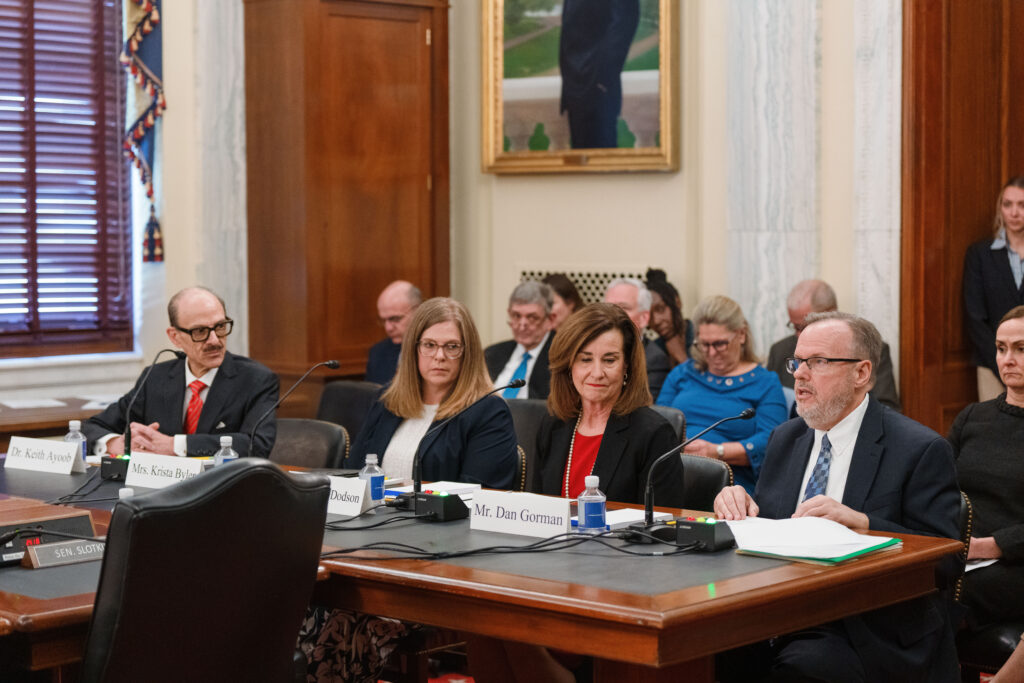WASHINGTON, April 1, 2025—In a hearing before the U.S. Senate Agriculture Committee today, lawmakers, nutrition experts, and school officials emphasized the need to restore whole and reduced-fat (2%) milk to federal school meal programs. The focus of the hearing was the Whole Milk for Healthy Kids Act, a bipartisan bill that would allow schools to offer these milk options to the more than 30 million students who rely on school breakfast and lunch every day.
For more than a decade, federal regulations have restricted schools to offering only fat-free and low-fat milk, despite widespread underconsumption of dairy among children. Between 68% and 94% of school-age boys and girls are failing to meet the recommended levels of dairy intake, depriving them of essential nutrients during key developmental years.
“Today’s hearing demonstrates the broad, bipartisan support the Whole Milk for Healthy Kids Act enjoys in Congress, and among parents, nutritionists and school meals professionals alike,” said Michael Dykes, D.V.M., president and CEO of the International Dairy Foods Association. “Whole and 2% milk provide kids with 13 essential nutrients and high-quality protein critical for growth, development, healthy immune function, and overall wellness. It’s time for Congress to pass the Whole Milk for Healthy Kids Act and bring whole and 2% milk back to schools.”
Falling Consumption and Food Waste
U.S. Senator Roger Marshall (R-Kan.), a physician, pointed out that milk consumption has declined since whole and 2% options were removed from schools. Krista Byler, district food service director for Union City Area School District in Pennsylvania, saw the results firsthand.
“It was heartbreaking what I was seeing at our little 1,000-student school district,” Byler testified. “The amount of waste that we were throwing away each day was disheartening. With the new legislation in place, my dairy orders also greatly declined.”
Dr. Eve Stoody of the U.S. Department of Agriculture noted that dairy intake among adolescents is now about half a cup lower than it was two decades ago. “Efforts to increase dairy intakes would improve nutrient intakes and support overall health,” said Stoody. “Offering dairy during school meals supports consumption directly and can also set the stage for consuming a healthy dietary pattern outside of school meals.”
Recent Science Supports Whole and 2% Milk
Experts also pointed to the evolution of nutrition science, which increasingly shows neutral or positive effects of full-fat dairy.
“A plethora of scientific literature demonstrates that consumption of cow’s milk provides children with better bone health, a lower risk for type 2 diabetes, and a lower risk for cardiovascular disease,” said Dr. Keith Ayoob, associate professor emeritus in the Department of Pediatrics at Albert Einstein College of Medicine. “No matter what type of milk is offered in school, none of it is nutritious unless students drink it. I believe that giving children the kind of milk option they like can encourage participation in the school meals program, and that’s my goal.”
Dr. Ayoob added that more than 80% of American households purchase whole and reduced-fat milk at home, suggesting that aligning school offerings with family habits could further boost consumption.
He also addressed concerns about saturated fat and obesity, noting, “Saturated fat doesn’t exist in isolation in foods. In dairy, it is bound to protein, occurring in a ‘dairy protein-fat matrix.’ In this form, the body appears to handle it differently—it may not increase bad cholesterol and can even reduce the harmful part of it.” On obesity, Ayoob stated, “With milk, research has consistently shown that consumers of whole milk are no more likely to be overweight or obese. In terms of other health risks, higher dairy consumption, irrespective of dairy fat content, has been associated with lower risk for insulin resistance syndrome”, or the conditions leading to prediabetes, type 2 diabetes, cardiovascular disease and high blood pressure.
Legislative Outlook
The hearing marks a critical next step in the legislative process for the Whole Milk for Healthy Kids Act, which was approved by the U.S. House Education and Workforce Committee with a strong, bipartisan vote of 24-10 in February. The bill awaits passage by both the House and the Senate. Join IDFA in advocating for this important legislation at www.idfa.org/wholemilkcampaign.
Learn more about the importance of milk—especially whole and 2% milk—in the diets of healthy children at www.wholemilkforkids.com.
# # #
Contact: press@idfa.org
The International Dairy Foods Association (IDFA), Washington, D.C., represents the nation’s dairy manufacturing and marketing industry, which supports more than 3.2 million jobs that generate $49 billion in direct wages and $794 billion in overall economic impact. IDFA’s diverse membership ranges from multinational organizations to single-plant companies, from dairy companies and cooperatives to food retailers and suppliers, all on the cutting edge of innovation and sustainable business practices. Together, they represent most of the milk, cheese, ice cream, yogurt and cultured products, and dairy ingredients produced and marketed in the United States and sold throughout the world. Delicious, safe and nutritious, dairy foods offer unparalleled health and consumer benefits to people of all ages.

